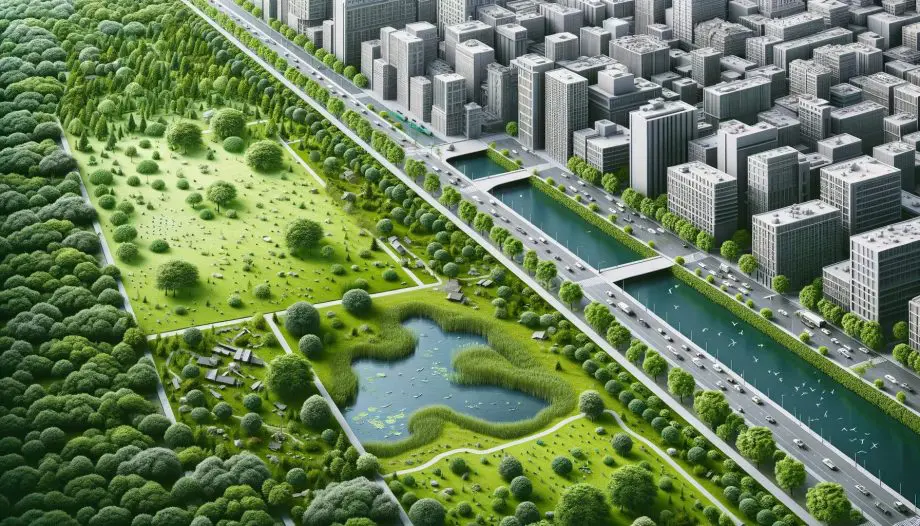
Technology Advances Nature-Based Solutions Key Takeaways:
- Technology is Advancing Nature-Based Solutions involves integrating innovative technologies like AI, remote sensing, and GIS with natural processes.
- This synergy enhances the effectiveness, efficiency, and scalability of solutions addressing environmental challenges, such as climate change, water management, and urban sustainability.
Welcome to the fascinating world where we find out how technology is advancing Nature-Based Solutions and takes center stage!
Join us as we delve into the incredible synergy of cutting-edge tech and nature’s own strategies, transforming the way we tackle environmental and societal challenges.
It’s a journey where green meets genius!
Introduction to Nature-Based Solutions and Technology
In our increasingly digital world, the convergence of technology with nature-based solutions (NbS) presents a promising avenue for addressing environmental and societal challenges.
Nature-based solutions, rooted in the sustainable use of natural ecosystems, offer a holistic approach to issues like global warming, biodiversity loss, and water security.
When intertwined with technological advancements, these solutions transform, elevating their efficiency and effectiveness.
This synergy not only enhances ecosystem services and human well-being but also contributes significantly to sustainable urban development and climate change adaptation.
Nature-based Solutions leverage nature and the power of healthy ecosystems to protect people, optimise infrastructure and safeguard a stable and biodiverse future. IUCN
How Technology is Advancing Nature-Based Solutions

Definition and Importance of NbS:
-
- Nature-based solutions (NbS) are methods that leverage natural processes and ecosystems to address societal and environmental challenges.
-
- This approach is increasingly recognized for its ability to provide multiple benefits, including enhancing biodiversity, improving water quality, and contributing to carbon sequestration.
-
- NbS plays a crucial role in climate change adaptation and mitigation. They help in reducing the impact of natural disasters, such as floods and landslides, by restoring natural barriers.
-
- Additionally, NbS like urban green spaces can improve air quality and reduce the urban heat island effect, directly benefiting human health.
-
- Sustainable use of natural ecosystems through NbS involves practices like regenerative agriculture, which not only restores soil health but also improves food security.
-
- These practices are essential for maintaining the balance of natural systems and supporting biodiversity.
Techno-Ecological Approaches:
-
- Techno-ecological approaches refer to the integration of technological innovations with NbS.
-
- This includes the use of remote sensing for monitoring natural ecosystems, employing digital tools for data analysis, and applying AI for predicting and managing environmental impacts.
-
- Recent advancements like satellite monitoring and machine learning algorithms have revolutionized NbS implementation.
-
- They enable better tracking of ecosystem changes, assessment of NbS effectiveness, and informed decision-making for conservation and restoration projects.
-
- Technologies like GIS (Geographic Information Systems) are crucial in mapping and planning NbS.
-
- They help in identifying potential areas for habitat restoration, urban green space development, and water conservation strategies.
The synergy between Technology and Nature:
-
- The synergy between technology and nature is evident in projects that combine natural processes with innovative solutions.
- For example, green infrastructure in urban areas often includes engineered solutions like green roofs and rain gardens, which mimic natural water management processes.
-
- AI and machine learning are being used to optimize NbS for better outcomes.
- For instance, algorithms can predict which areas are most suitable for reforestation or wetland restoration based on various environmental factors.
-
- This integration is significantly beneficial for local communities and urban environments.
- It leads to improved urban planning that incorporates green spaces and sustainable water management systems, enhancing the quality of life and resilience against climate impacts.
Techno-Ecological Approaches in Water Management
Techno-ecological approaches in water management exemplify the innovative union of technology and nature-based solutions.
By integrating green technologies in water treatment and management, these methods significantly enhance water quality and contribute to ecosystem services, showcasing a transformative impact on both environmental sustainability and human well-being.
Green Technologies in Water Treatment:
-
- Technologies like biofiltration systems use natural processes to remove contaminants from water, offering a more sustainable alternative to chemical treatments.
-
- Low-cost cascade aeration systems enhance the air-water transfer of gases like oxygen, improving water quality and reducing the need for chemical oxygenation.
-
- Green technologies also include the use of constructed wetlands for wastewater treatment, which not only purify water but also create habitats for wildlife.
Case Studies of Techno-Ecological Water Management:
-
- In Singapore, the NEWater project uses advanced membrane technologies and ultraviolet disinfection to treat reclaimed water, successfully supplementing the country’s water supply.
-
- The Netherlands employs a sophisticated water management system that integrates natural floodplains and controlled flooding areas, reducing flood risk while enhancing biodiversity.
-
- In the United States, cities like Portland and Philadelphia have implemented green stormwater infrastructure, combining rain gardens, green roofs, and permeable pavements to manage stormwater sustainably.
Impact on Water Quality and Ecosystem Services:
-
- Techno-ecological water management systems improve water quality by reducing pollutants, thereby benefiting aquatic life and human health.
-
- These systems often enhance local biodiversity by creating new habitats and supporting a variety of species.
-
- Additionally, they provide ecosystem services like flood control, groundwater recharge, and climate regulation.
Table: Comparison of Traditional and Techno-Ecological Water Management Approaches
| Aspect | Traditional Water Management | Techno-Ecological Water Management |
|---|---|---|
| Approach | Often relies on chemical treatments and physical infrastructure | Combines natural processes with technological innovations |
| Environmental Impact | Can be harmful to ecosystems due to chemical usage | Enhances ecosystems, supports biodiversity |
| Sustainability | May require continuous resource input and maintenance | More sustainable, often lower maintenance |
| Cost | Potentially high long-term costs | Cost-effective in the long run |
| Water Quality | Effective but may not support biodiversity | Improves water quality, supports biodiversity |
| Community Engagement | Typically low | Often involves community in green space management |
In a Nutshell:
This section highlights the effectiveness of techno-ecological approaches in enhancing water management through sustainable and innovative solutions, providing real-world examples and demonstrating their impact on ecosystems and human communities.
NbS in Urban Planning and Development
Nature-based solutions (NbS) are revolutionizing urban planning and development, offering sustainable ways to enhance city living.
By incorporating elements like green spaces and water management systems, NbS provides significant benefits to urban environments, enhancing the health and well-being of local communities.
Role of NbS in Urban Green Infrastructure:
-
- NbS contributes to urban green infrastructure by integrating natural elements into city landscapes. This includes the development of parks, green roofs, and green walls.
-
- Urban green spaces not only offer recreational areas for residents but also play a crucial role in mitigating urban heat islands, improving air quality, and reducing noise pollution.
-
- Green infrastructure also encompasses sustainable water management systems like rain gardens and permeable pavements, which help in managing stormwater and reducing flood risks.
Benefits to Local Communities and Human Health:
-
- NbS in urban areas have been linked to improved mental and physical health outcomes for residents.
-
- Green spaces provide areas for exercise, relaxation, and social interaction, which are vital for mental health and community cohesion.
-
- These solutions also contribute to reducing air pollution and heat stress, directly benefiting respiratory and cardiovascular health.
-
- Urban NbS can increase property values, enhance the aesthetic appeal of neighborhoods, and foster a sense of community belonging.
Case Studies in Urban Areas:
-
- In Copenhagen, Denmark, the implementation of green roofs and extensive bike lanes has made the city more sustainable and livable, improving air quality and providing accessible green spaces.
-
- Melbourne, Australia, focuses on increasing urban canopy coverage to reduce heat stress and improve air quality, actively involving the community in tree planting initiatives.
-
- In Singapore, the integration of parks and natural waterways into the urban landscape, like the Bishan-Ang Mo Kio Park, has created multifunctional spaces that enhance biodiversity and offer recreational opportunities.
Table: Examples of NbS in Different Urban Settings
| City | Nature-Based Solution | Benefit |
|---|---|---|
| Copenhagen, Denmark | Green Roofs and Bike Lanes | Improved air quality, reduced carbon emissions |
| Melbourne, Australia | Urban Canopy Coverage | Reduced heat stress, improved air quality |
| Singapore | Integration of Parks and Waterways | Enhanced biodiversity, recreational spaces |
| Portland, USA | Green Stormwater Infrastructure | Reduced flood risk, improved water quality |
| Stuttgart, Germany | Network of Green Spaces | Reduced heat island effect, enhanced biodiversity |
In a Nutshell:
This section underscores how NbS are crucial in making urban areas more livable and sustainable, providing a range of benefits from environmental enhancements to community well-being and health improvements.
Emerging Technologies and NbS Implementation

Emerging technologies are playing a pivotal role in enhancing the implementation and effectiveness of nature-based solutions (NbS).
From AI and remote sensing to economic incentives like carbon credits, technology is not just supporting but also scaling up the impact of NbS in various sectors.
Role of AI and Machine Learning in NbS:
-
- AI and machine learning are crucial in analyzing large datasets to identify patterns and trends that aid in NbS planning and implementation.
-
- They help in predicting environmental changes, assessing risks, and determining the most effective NbS strategies.
-
- These technologies enable the optimization of NbS for specific outcomes, such as identifying the best locations for tree planting to maximize carbon sequestration or urban cooling.
-
- AI algorithms also assist in monitoring the health and growth of natural ecosystems, providing valuable insights for ongoing management and adaptation strategies.
Remote Sensing and Satellite Monitoring in NbS:
-
- Remote sensing technologies and satellite monitoring are extensively used for large-scale environmental monitoring, offering a comprehensive view of landscapes and ecosystems.
-
- These tools are instrumental in tracking changes in land cover, monitoring the progress of reforestation projects, and assessing the health of natural habitats.
-
- Satellite imagery is also used to detect and analyze environmental phenomena like deforestation, urban sprawl, and the effects of climate change, thus informing NbS strategies.
Economic Benefits and Carbon Credits through Technology in NbS:
-
- The integration of technology in NbS can unlock significant economic benefits, particularly in the realm of carbon credits and sustainable development.
-
- Technologies like blockchain are being explored to ensure transparency and efficiency in carbon credit trading, directly linked to NbS like reforestation and wetland restoration.
-
- Economic benefits also extend to the value chains and local communities involved in NbS, with technology enabling better access to markets, data-driven decision-making, and increased profitability.
Table: Technological Tools Used in NbS and Their Applications
| Technology | Application in NbS | Benefit |
|---|---|---|
| AI and Machine Learning | Optimizing NbS strategies, ecosystem health monitoring | Enhanced efficiency, predictive analysis |
| Remote Sensing | Environmental monitoring, land cover change analysis | Comprehensive ecosystem assessment, real-time data |
| Satellite Monitoring | Tracking reforestation and habitat restoration | Global scale monitoring, progress tracking |
| Blockchain | Carbon credit trading | Transparency and efficiency in carbon markets |
| GIS | Planning and mapping of NbS | Informed decision-making, spatial analysis |
In a Nutshell:
This section highlights how emerging technologies are not only supporting but also amplifying the effectiveness and reach of NbS, leading to both environmental and economic advancements.
Global Warming, Climate Crisis, and NbS
As the world grapples with the escalating climate crisis, nature-based solutions (NbS) have emerged as vital tools in mitigating global warming.
These sustainable strategies not only contribute to carbon sequestration but also play a key role in helping nations meet their Paris Agreement targets.
NbS in Mitigating Global Warming and Climate Crisis:
-
- NbS, such as reforestation, wetland restoration, and urban greening, are effective in absorbing carbon dioxide from the atmosphere, thereby reducing global warming.
-
- These solutions also help in adapting to climate change impacts by enhancing natural resilience against extreme weather events, like floods and heat waves.
-
- NbS supports biodiversity conservation, which is crucial for maintaining ecological balance and combating the effects of a changing climate.
Carbon Sequestration and Storage:
-
- Forests, wetlands, and oceans play a significant role in carbon sequestration and storage, acting as natural carbon sinks.
-
- Practices like regenerative agriculture and soil conservation contribute to increased carbon storage in soil, further mitigating greenhouse gas emissions.
-
- Urban NbS, such as green roofs and parks, also contribute to carbon sequestration in urban environments, reducing the carbon footprint of cities.
Role of NbS in Meeting Paris Agreement Targets:
-
- NbS are integral to many countries’ strategies for meeting their Nationally Determined Contributions (NDCs) under the Paris Agreement.
-
- By implementing NbS, countries can reduce emissions, enhance their carbon sinks, and cost-effectively achieve their climate targets.
-
- International initiatives like the Bonn Challenge and the United Nations’ REDD+ program emphasize the role of forest restoration and sustainable land use in meeting global climate goals.
Table: Global Warming Metrics and Impact of NbS
| Global Warming Metric | Impact of NbS |
|---|---|
| Carbon Dioxide Levels | Reduction through reforestation and urban greening |
| Temperature Increase | Mitigation through increased canopy cover and green infrastructure |
| Frequency of Extreme Weather Events | Resilience enhancement through wetland restoration and sustainable land management |
| Biodiversity Loss | Prevention through habitat conservation and ecosystem restoration |
| Emission Reduction Targets | Contribution towards achieving NDCs under the Paris Agreement |
In a Nutshell:
This section underscores the critical role of NbS in addressing the challenges posed by global warming and the climate crisis, demonstrating how these natural strategies are essential for sustainable climate action and biodiversity conservation.
Challenges and Future Directions in NbS
While nature-based solutions (NbS) offer immense potential in addressing environmental and societal issues, their implementation faces various challenges.
Understanding these hurdles and exploring future trends and opportunities is crucial for maximizing the impact and sustainability of NbS.
Societal Challenges in Implementing NbS:
-
- One of the primary challenges is the lack of awareness and understanding among stakeholders about the benefits and functioning of NbS.
-
- Financing NbS can be a hurdle, as it often requires upfront investment, and the economic benefits, though significant, may be long-term.
-
- Integrating NbS into policy and planning requires cross-sectoral collaboration and alignment, which can be complex and time-consuming.
Future Trends in the Nature Tech Market:
-
- The nature tech market is anticipated to grow, with an increasing focus on integrating technology with NbS for more efficient and scalable solutions.
-
- Innovations in AI, remote sensing, and data analysis are expected to enhance the planning, implementation, and monitoring of NbS.
-
- The market is also likely to see a rise in public-private partnerships, fostering new investment opportunities and collaborative approaches.
Potential for Sustainable Development and Disaster Risk Reduction:
-
- NbS are integral to achieving sustainable development goals (SDGs), particularly in areas like climate action, biodiversity conservation, and sustainable cities.
-
- The role of NbS in disaster risk reduction is increasingly recognized, with solutions like mangrove restoration and green infrastructure proving effective in reducing the impact of natural disasters.
-
- Future developments in NbS are expected to focus on creating resilient ecosystems and communities, capable of withstanding the effects of climate change and other environmental challenges.
Table: Current Challenges vs. Future Opportunities in NbS
| Challenges | Future Opportunities |
|---|---|
| Awareness and Understanding | Increased education and stakeholder engagement |
| Financing and Investment | New funding models and public-private partnerships |
| Policy Integration | Stronger regulatory frameworks and incentives |
| Cross-Sectoral Collaboration | Enhanced cooperation between sectors and disciplines |
| Technological Limitations | Advances in nature tech and data-driven solutions |
| Disaster Resilience | Improved capacity for disaster risk reduction |
In a Nutshell:
This section highlights the complexities involved in implementing NbS, while also pointing towards a future where technology, policy, and societal engagement converge to enhance the effectiveness and reach of nature-based solutions.
How Technology is Advancing Nature-Based Solutions FAQs
Understanding the nuances of nature-based solutions (NbS) and their technological integration can be complex.
This FAQ section addresses common queries to clarify concepts and applications, helping readers gain a deeper insight into this innovative approach to environmental and societal challenges.
Q: What are Nature-Based Solutions (NbS)?
A: Nature-based solutions involve using natural processes and ecosystems to address various environmental and societal challenges.
Examples include reforestation, urban greening, wetland restoration, and sustainable agriculture practices.
Q: How do technologies enhance NbS?
A: Technologies like AI, remote sensing, and GIS enhance NbS by providing data-driven insights for better planning, implementation, and monitoring.
They help in identifying optimal locations for NbS, assessing their effectiveness, and tracking their impact on the environment.
Q: Can NbS help in combating climate change?
A: Yes, NbS plays a crucial role in combating climate change. They help sequester carbon, reduce greenhouse gas emissions, and enhance resilience against climate impacts like floods and heat waves.
By restoring and protecting natural ecosystems, NbS contributes significantly to climate change mitigation and adaptation.
Q: What are the economic benefits of implementing NbS?
A: NbS offers various economic benefits, including cost savings in urban infrastructure, enhanced property values, and potential revenue from carbon credits.
They also support sustainable development by providing resources and services that contribute to local economies.
Q: What challenges are associated with implementing NbS?
A: Challenges include securing adequate funding, integrating NbS into policy and planning, ensuring stakeholder collaboration, and overcoming technological limitations.
Raising awareness and understanding of NbS benefits among communities and decision-makers is also crucial.
Q: How do NbS impact urban environments?
A: In urban environments, NbS improves air and water quality, reduces urban heat island effects, enhances biodiversity, and provides recreational spaces.
They also contribute to stormwater management and flood control, improving urban resilience.
Q: What future trends are expected in the field of NbS and technology?
A: Future trends include the growth of the nature tech market, with advancements in AI, machine learning, and remote sensing.
There’s an expected increase in public-private partnerships and collaborative approaches to funding and implementing NbS.
The integration of technology will continue to play a significant role in enhancing the efficiency and scalability of NbS.
Technology Advancing NbS Conclusion
The integration of nature-based solutions (NbS) with emerging technologies marks a significant stride towards addressing some of the most pressing environmental and societal challenges of our time.
This fusion not only enhances the effectiveness of NbS but also opens new avenues for sustainable development and climate resilience.
Summarizing the Impact of NbS:
-
- NbS, ranging from urban greening to wetland restoration, have shown immense potential in improving ecosystem services, enhancing biodiversity, and contributing to carbon sequestration.
-
- In urban settings, NbS has transformed cityscapes, providing green spaces that improve air quality, reduce heat stress, and foster community well-being.
Technological Advancements in Enhancing NbS:
-
- The role of technology, especially AI, remote sensing, and GIS, in advancing NbS has been pivotal. These tools have enabled better planning, efficient implementation, and effective monitoring of NbS projects.
-
- Emerging technologies are set to further revolutionize NbS, making them more accessible, scalable, and impactful.
Challenges and Opportunities Ahead:
-
- While challenges like funding, policy integration, and stakeholder collaboration persist, the future of NbS is promising. Innovative funding models, stronger policy frameworks, and increased stakeholder awareness can address these challenges.
-
- The growing nature tech market and public-private partnerships present significant opportunities for the advancement of NbS.
The Road Forward:
As we move forward, the integration of NbS and technology will play a crucial role in shaping sustainable and resilient communities.
Collaborative efforts, continuous innovation, and a commitment to sustainable practices are essential for harnessing the full potential of NbS.
In conclusion, nature-based solutions, empowered by technological innovations, hold the key to a more sustainable and resilient future.
By embracing these solutions, we can effectively address the challenges posed by climate change and urbanization, ensuring a healthier planet for current and future generations.
Read more: Nature-Based Solutions to Climate Change
Resources
To deepen your understanding of nature-based solutions (NbS) and their integration with technology, the following resources provide valuable information and insights.
These resources cover a range of topics from the basics of NbS to their application in urban planning and water management, as well as the role of technology in enhancing these solutions.
- Nature-Based Solutions for Water by The United Nations World Water Development Report: This report provides a comprehensive overview of how nature-based solutions can address water management challenges. Access the report here.
- Techno-Ecological Synergy of Nature-Based Solutions in Cities from Environmental Science & Technology: This research article explores the synergy between technology and NbS, particularly in urban environments. Read the article here.
- Nature-Based Solutions to Climate Change Adaptation in Urban Areas – Theory and Practice of Urban Sustainability Transitions: This book offers insights into the application of NbS in urban areas for climate change adaptation. Find more information here.
- Integrating Green and Gray – Creating Next Generation Infrastructure by World Bank and World Resources Institute: This resource delves into how combining green infrastructure with traditional approaches can lead to sustainable solutions. Access the publication here.
- The Power of Nature in Business and Climate Resilience by the World Economic Forum: This article discusses the role of NbS in business strategies and their impact on climate resilience. Read the article here.
- Global Forest Watch by World Resources Institute: An interactive online platform providing data, technology, and tools for monitoring forests and tracking deforestation. Explore Global Forest Watch here.
- Nature-based Solutions for Climate Change Mitigation by the Nature Conservancy: This resource offers a detailed analysis of how NbS can mitigate climate change impacts. Access the resource here.
These resources are instrumental in gaining a well-rounded understanding of the field of NbS and its critical role in sustainable development and climate change mitigation and adaptation.






